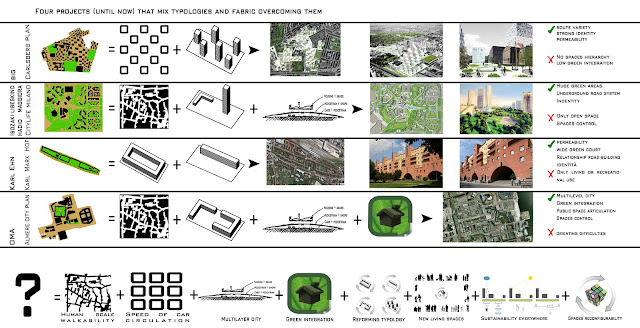How do you draw a city?
How do you set up a quality urban environment that fosters trade and social relations enriching people's lives?
The answer to these questions, considering the scale of the urbanization project of the former SDO Casilino (something more than a hundred hectares) requires analysis and therefore reflections that have to start from the study of existing tissues, trying to catch in them the strengths and turn away weaknesses.
The development of urban centers around the world has followed for hundreds of years the criteria of randomness and arbitrariness, and without considering the oldest examples of planned development (Roman net and Pienza to name two well-known), this phenomenon has led to the configuration of urban fabric that we usually identify with the historical centers of cities: this type of tissue is called "stratified city".
STRATIFIED CITY: THE HISTORIC CENTRE OF LECCE
STRATIFIED CITY: THE HISTORIC CENTRE OF ROME
Starting instead from the second industrial revolution, in which the call of the factories and work has brought the inhabitants of rural areas to concentrate in cities, the criterion of stratification has reached and exceeded its limits with the appearance, at a later time, of the car: from this moment in history has been evident the need to anticipate and address urban sprawl, resulting in the "planned city".
PLANNED CITY: SUBURBS OF SEOUL
PLANNED CITY: THE EIXAMPLE OF BARCELONA
Having identified in a rather simplistic way the planned and stratified tissue types, deriving from their observation come some easy considerations, with the aim to frame its salient features.
The layered city is thought and lived on a human scale, in that the mobility system is generally composed of streets of small size, then resulting in large areas of socialization (squares); inherent in this type of urban fabric is the articulation of space resulting from the stratification: the roads are often winding and sizes different from each other, the buildings are not aligned up on the street frontage and their dimensions and colors are also variables.
The result is an articulated small-scale spatial system, with a well defined relationship between full and empty spaces: small voids (streets) and large blocks (buildings).This type of fabric is perfect for relatively low-density housing and to be enjoyed moving by feet, but denotes serious deficiencies (health and public order i.e.) with high population densities and when is lived mainly moving by private means (lack of parking , high noise and environmental pollution).
The planned city has been created to compensate for these shortcomings, it would also be designed to be lived on a human scale, but his vocation has been shown to be lived on a car scale.
In this sense, the streets are wide, linear, there is not the articulation of the spaces of the stratified city: the relationship between blocks and voids is substantially changed and sees large voids and large, linear blocks.
In this way, there is the presumption to make all public spaces spots of socialization,ignoring or distorting the suggestions that come from hundreds of years of history of tissue stratification, that sees only few setted places (the squares) as spots of socialization.
The goal that we set is to identify the laws by which the cities are stratified, studying them drawing development models and repropose them in a contemporary key in the urban planning process of the SDO Casilino















